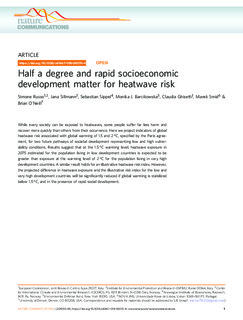| dc.contributor.author | Russo, Simone | |
| dc.contributor.author | Sillmann, Jana | |
| dc.contributor.author | Sippel, Sebastian | |
| dc.contributor.author | Barcikowska, Monika J. | |
| dc.contributor.author | Ghisetti, Claudia | |
| dc.contributor.author | Smid, Marek | |
| dc.contributor.author | O'Neill, Brian | |
| dc.date.accessioned | 2019-07-10T07:58:22Z | |
| dc.date.available | 2019-07-10T07:58:22Z | |
| dc.date.created | 2019-01-16T10:43:11Z | |
| dc.date.issued | 2019-01-11 | |
| dc.identifier.citation | Nature Communications. 2019, 10 (1), 1-9. | nb_NO |
| dc.identifier.issn | 2041-1723 | |
| dc.identifier.uri | http://hdl.handle.net/11250/2603990 | |
| dc.description.abstract | While every society can be exposed to heatwaves, some people suffer far less harm and recover more quickly than others from their occurrence. Here we project indicators of global heatwave risk associated with global warming of 1.5 and 2 °C, specified by the Paris agreement, for two future pathways of societal development representing low and high vulnerability conditions. Results suggest that at the 1.5 °C warming level, heatwave exposure in 2075 estimated for the population living in low development countries is expected to be greater than exposure at the warming level of 2 °C for the population living in very high development countries. A similar result holds for an illustrative heatwave risk index. However, the projected difference in heatwave exposure and the illustrative risk index for the low and very high development countries will be significantly reduced if global warming is stabilized below 1.5 °C, and in the presence of rapid social development. | nb_NO |
| dc.language.iso | eng | nb_NO |
| dc.rights | Navngivelse 4.0 Internasjonal | * |
| dc.rights.uri | http://creativecommons.org/licenses/by/4.0/deed.no | * |
| dc.subject | Heatwawe risk | nb_NO |
| dc.subject | Global warming | nb_NO |
| dc.title | Half a degree and rapid socioeconomic development matter for heatwave risk | nb_NO |
| dc.type | Journal article | nb_NO |
| dc.type | Peer reviewed | nb_NO |
| dc.rights.holder | © The Author(s) 2019 | nb_NO |
| dc.subject.nsi | VDP::Landbruks- og Fiskerifag: 900::Landbruksfag: 910 | nb_NO |
| dc.source.pagenumber | 1-9 | nb_NO |
| dc.source.volume | 10 | nb_NO |
| dc.source.journal | Nature Communications | nb_NO |
| dc.source.issue | 1 | nb_NO |
| dc.identifier.doi | 10.1038/s41467-018-08070-4 | |
| dc.identifier.cristin | 1657973 | |
| dc.relation.project | Norges forskningsråd: 243953 | nb_NO |
| dc.relation.project | Norges forskningsråd: 244551 | nb_NO |
| cristin.unitcode | 7677,4,0,0 | |
| cristin.unitname | Divisjon for miljø og naturressurser | |
| cristin.ispublished | true | |
| cristin.qualitycode | 2 | |

